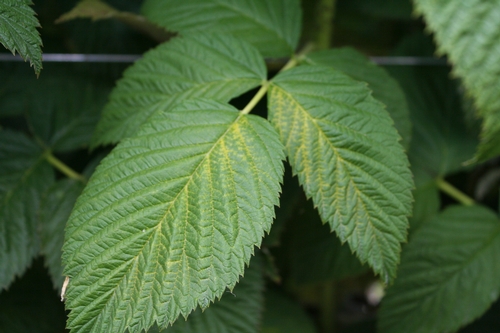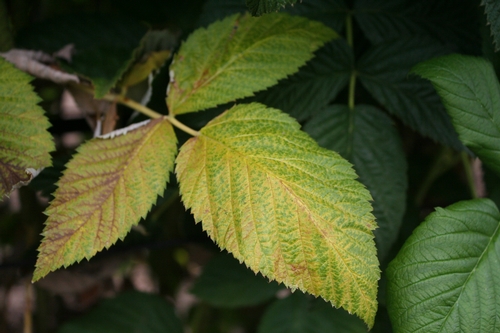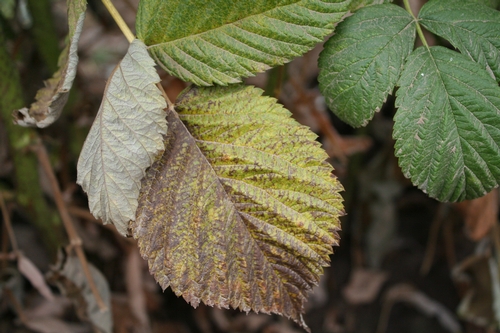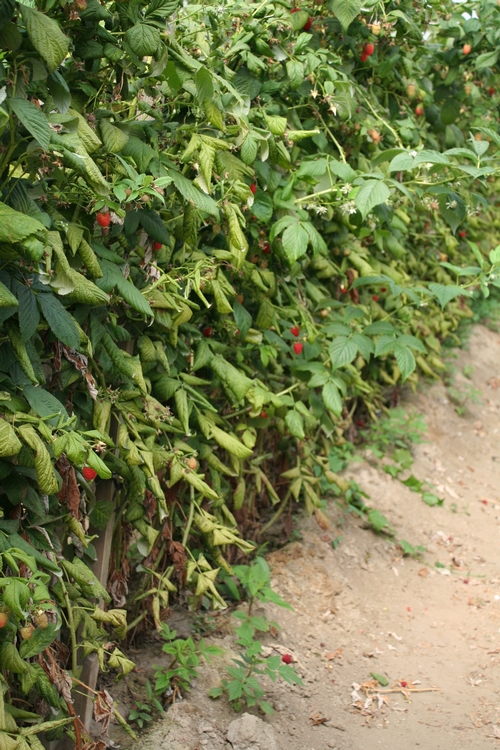Since June of this year there has been a spate of yellowing and senescing (dying) of leaves of certain raspberries. This problem is widespread in the Watsonville and Salinas production district and first appears as a yellowing of the older leaves toward the bottom of the plant. The symptoms appear evenly distributed through the field with very little patchiness in incidence. The yellowing tends to follow a mottled pattern (Photo 2 below) and surprisingly can be pretty bounded on the leaf, for example on one half and not the other. Affected leaves end up separating from the main plant quite easily. The yellowing and dieback most often occurs on the lower half of the plant, and rarely advances higher nor does it result in total plant death. From growers and personal observations this yellowing and senescing usually does not appear to result in any reduction in plant vigor or yield, but there are occasions of total plant loss. There are reports of occasional loss of fruit integrity and crumbliness in affected fields, but this is strictly anecdotal.
The lengthy report below is a summary of the multifold approach we took to studying this issue followed by a discussion at the end regarding what is the most likely cause.
Arthropods: Arthropods are not the cause of this problem. One grower reported a correlation with a certain type of mite and while there were patches of twospotted spider mites in some locations, in others there were none nor had there ever been. Beyond the mites, no other arthropods capable of causing leaf discoloration or necrosis were found.
Diseases: The leaf yellowing is not caused by a pathogen. A total of five whole plant samples (plant tops and roots) from several fields experiencing leaf yellowing were submitted to the UCCE diagnostic laboratory in Salinas, and in only one case did the test come up positive for a species of Phytophthora. As leaf yellowing can be caused by virus infection, for example Raspberry Bushy Dwarf Virus on the Autumn series of red raspberry, a set of leaf samples was tested at the UCCE diagnostic lab in Salinas and another distinct set totaling five samples was submitted to the CDFA disease diagnostic laboratory in Sacramento. All tests for virus came back completely negative.
Nutritional: Levels of nitrogen and phosphorous are below sufficiency and substantially lower in yellow leaves than in green leaves, and levels of calcium are above sufficiency (and well above sufficiency in a field of healthy green plants) and higher in yellow leaves than in green leaves. Soil concentrations of nitrates are below recommended levels of at least 10 ppm in three of four fields experiencing yellow leaves. Concentrations of the salts sodium and chloride are substantially lower in all fields experiencing leaf yellowing than a field of symptomless, apparently healthy plants.
Table 1. Leaf Samples. ‘Healthy Green’ refers to leaf samples taken from a field experiencing no yellowing anywhere; other Green and Yellow are paired sets coming from the same field and leaves collected from floricane at the same approximate height of about 18" above the soil. Samples consisted of at least 15 leaves coming from various parts of the field taken between July 16 and July 27.
|
|
Sample Description |
||||||||
|
Nutrient |
Healthy Green |
Green 1 |
Yellow 1 |
Green A |
Yellow A |
Green B |
Yellow B |
Green 2 |
Yellow 2 |
|
% N |
3.3 |
1.7 |
2.1 |
3.0 |
1.3 |
2.5 |
1.3 |
2.7 |
1.7 |
|
% P |
0.22 |
0.15 |
0.17 |
0.27 |
0.19 |
0.30 |
0.21 |
0.23 |
0.15 |
|
% K |
1.1 |
1.0 |
1.8 |
1.8 |
2.6 |
1.9 |
1.4 |
1.5 |
1.0 |
|
% Ca |
2.5 |
2.1 |
1.8 |
1.9 |
2.8 |
2.5 |
3.0 |
1.9 |
2.1 |
|
% Mg |
0.83 |
0.67 |
0.56 |
0.58 |
0.63 |
0.74 |
0.79 |
0.58 |
0.67 |
|
% S |
0.18 |
0.20 |
0.23 |
0.17 |
0.10 |
0.18 |
0.093 |
0.20 |
0.20 |
|
ppm Cu |
4.1 |
7.2 |
8.4 |
6.5 |
5.4 |
7.1 |
5.7 |
8.3 |
7.2 |
|
ppm Zn |
19 |
12 |
26 |
21 |
22 |
22 |
19 |
14 |
12 |
|
ppm Fe |
330 |
320 |
400 |
780 |
970 |
940 |
900 |
200 |
320 |
|
ppm Mn |
560 |
180 |
150 |
1600 |
1400 |
2000 |
1400 |
140 |
180 |
|
ppm B |
78 |
67 |
73 |
110 |
170 |
140 |
180 |
72 |
67 |
|
ppm Na |
160 |
270 |
210 |
110 |
290 |
140 |
220 |
270 |
270 |
|
ppm Cl |
390 |
2500 |
320 |
4100 |
3900 |
4900 |
6000 |
2900 |
2500 |
|
ppm NO3- N |
2500 |
300 |
340 |
610 |
400 |
180 |
460 |
790 |
300 |
|
|
Sample Description |
|||||
|
Nutrient |
Green 3 |
Yellow 3 |
Green 4 |
Yellow 4 |
Average Green* |
Average Yellow |
|
% N |
2.6 |
2.0 |
2.8 |
1.9 |
2.6 |
1.7 |
|
% P |
0.20 |
0.12 |
0.24 |
0.13 |
0.23 |
0.16 |
|
% K |
1.2 |
0.74 |
1.80 |
0.95 |
1.53 |
1.4 |
|
% Ca |
1.2 |
1.6 |
0.9 |
2.0 |
1.8 |
2.2 |
|
% Mg |
0.44 |
0.52 |
0.38 |
0.67 |
0.57 |
0.64 |
|
% S |
0.19 |
0.18 |
0.17 |
0.18 |
0.18 |
0.17 |
|
ppm Cu |
6.5 |
6.6 |
6.3 |
8.3 |
7.0 |
6.9 |
|
ppm Zn |
13 |
10 |
15. |
18 |
16 |
18 |
|
ppm Fe |
240 |
290 |
277 |
1020 |
460 |
650 |
|
ppm Mn |
270 |
340 |
250 |
579 |
740 |
675 |
|
ppm B |
71 |
85 |
56 |
128 |
86 |
117 |
|
ppm Na |
120 |
170 |
200 |
600 |
185 |
293 |
|
ppm Cl |
3600 |
5100 |
4000 |
7000 |
3667 |
4136 |
|
ppm NO3- N |
350 |
93 |
- |
- |
446 |
318 |
*Healthy sample excluded from these calculations.
Table 2. Soil Samples. Soil samples are a total of 10 6” deep cores taken from areas experiencing yellow leaves. The surface crust of the soil was brushed away before sampling. All soil samples were taken July 27.
|
|
Sample Description* |
||||
|
Data |
Healthy Green |
Yellow 1 |
Yellow A |
Yellow 2 |
Yellow 3 |
|
NO3-N (ppm) |
33 |
4.2 |
16 |
4.7 |
<2 |
|
P (ppm) |
120 |
98 |
130 |
100 |
130 |
|
K (ppm) |
240 |
580 |
340 |
210 |
260 |
|
Ca (ppm) |
3300 |
3000 |
2700 |
2000 |
2300 |
|
Mg (ppm) |
840 |
550 |
400 |
340 |
400 |
|
SO4-S (meq/L) |
8.6 |
1.3 |
7.5 |
4.3 |
4.2 |
|
Na (ppm) |
100 |
74 |
53 |
40 |
50 |
|
Cl (ppm) |
110.1 |
22.0 |
23.8 |
22.7 |
34.8 |
|
CEC (meq/100 g) |
24 |
21 |
19 |
13 |
16 |
|
pH |
7.1 |
6.9 |
5.5 |
6.8 |
7.2 |
*The designations “Healthy Green, Yellow 1, Yellow 2 and so on correspond with the same designations for the leaves above, meaning they come from the same fields.
Discussion: This issue of yellowing leaves in raspberry is not being caused by insects, mites or disease but we do find a striking difference in the concentration of some nutrients in affected leaves and the soils from from which they come. Since all the fields in question here are being managed by extremely competent and experienced growers we can be certain this nutritional deficiency is not being caused by a simple lack of fertilizer application, so we must explore this a little further.
All of the plants experiencing leaf yellowing and senescence are being grown in macro-tunnels. The PCA attending each of these fields reports that they have been very warm on the inside compared to outside and interestingly found a high level of humidity as well. This adds something to our investigation, since high temperatures can be a factor affecting the growth of plants, especially plants such as raspberry adapted to temperate climates. Heat injury in plants often results leaf yellowing and senescence.
Leaf nitrogen and phosphorous are lower in yellow leaves than green leaves. Leaf senescence is often preceded by the degradation and subsequent loss of chlorophyll, the lack of which of course means the leaf stops being green. A quick perusal of a book concerned with the mineral nutrition of plants (the excellent “Mineral Nutrition of Plants” by Horst Marschner I recommend highly) tells us that leaf senescence results in a net mobilization or export of nutrients from the dying tissue to still living and growing tissue. And we are seeing exactly this in the fields, since the plant tops continue to flourish and produce flowers and fruit all the while the bottoms are yellowing and dying.
But what of the higher concentrations of calcium in yellow leaves compared to green? They are quite high, near or above what are normally considered levels of sufficiency. Calcium, in contrast with other plant essential minerals is moved from the roots to the rest of the plant via evapotranspiration through the water conducting elements (also known as the xylem). This is meaningful since this means we tend to see higher levels of calcium deposition in plants moving lots of water.
Soil concentrations of nitrate, sodium and chloride are all low in fields experiencing leaf yellowing and necrosis. Knowing however that all three are leachable by water is again helpful.
The Bottom Line: What we are getting is that the tunnels are hot and killing some of the leaves towards the bottom of the plant. The plants continue to grow though, reallocating nutrients from the dying leaves to the younger ones and pulling up plenty of water because the rate of evapotranspiration is high in the heat of the tunnel. The grower response of adding more water to keep up is of course the correct one, but this is resulting in a lot of leaching. For salts like sodium and chloride this good, for a plant essential ion like nitrate it is not. So not only is nitrogen being transported away from the dying leaves, it is also being leached away in the soil before the plant can get it.
Probably the best response to this situation would be the one which has already been taken, and that is to open the tunnels to enhance air circulation and lower the internal temperatures.
I would like to thank PCA Eryn Gray for sharing his data and insight along with the growers involved in this work without whose participation none of this would have possible.
Attached Images:



